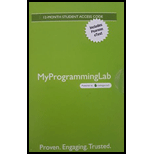
MYPROGRAMMINGLAB WITH PEARSON ETEXT
8th Edition
ISBN: 9780134225340
Author: Deitel
Publisher: PEARSON
expand_more
expand_more
format_list_bulleted
Question
Chapter 4, Problem 4.22E
Program Plan Intro
- Declare the counter variables for each letter grade, the total counter and the total value of all the grades.
- Prompt the user to enter the letter grades.
- Declare a WHILE loop in order to continue the process until the user enters the exit character.
- The SWITCH statement is used in order to increase the counter of the corresponding letter grades.
- Increase the letter grade counter and the total grade counter by one each time and add the value or mark of the grade.
- After the user enters the exit character, divide the total value by the count of grades entered in order to obtain the average mark.
- Using IF conditions, determine the grade corresponding to the average mark.
Summary Introduction:
To modify the program provided in fig 4.7 to print the average letter grade of the class based on entered letter grades.
Program description:
The main purpose of this program is to take the user entered values for the letter grades of a class and to determine the average grade of the class based on those letters. The program uses a SWITCH statement to count the number of occurrences of each grade and thereafter, it determines the average grade with the help of IF conditions.
Expert Solution & Answer
Want to see the full answer?
Check out a sample textbook solution
Students have asked these similar questions
Create a relationship between the common field (Technician Number) of the two tables. Make sure that each client must have 1 and only 1 technician assigned, and each technician can have multiple clients.
2. Create a query to show the Client Number, Client Name, Billed, Paid for clients in Anderson city. Save the query.
3. Create a query to show the Technician Number, Last Name, First Name, YTD Earnings for technicians whose Hourly Rate is greater than or equal to 30. Save the query.
4. Create a query to show Client Number, Client Name, Billed, Paid for clients whose technician number is 22 and whose Billed is over 300. Save the query.
5. Create a query to show the Technician Number, Last Name, First Name, Client Number, Client Name for clients whose technician number 23. Save the query.
6. Create a query to show the Technician Number, Last Name, First Name, Client Number, Client Name for clients whose technician number 23 or 29. Save the query Help please Microsoft office access
Dijkstra's Algorithm (part 1). Consider the network shown below, and Dijkstra’s link-state algorithm. Here, we are interested in computing the least cost path from node E (note: the start node here is E) to all other nodes using Dijkstra's algorithm. Using the algorithm statement used in the textbook and its visual representation, complete the "Step 0" row in the table below showing the link state algorithm’s execution by matching the table entries (i), (ii), (iii), and (iv) with their values. Write down your final [correct] answer, as you‘ll need it for the next question.
4. |z + 5 - 5i| = 7
Chapter 4 Solutions
MYPROGRAMMINGLAB WITH PEARSON ETEXT
Ch. 4 - Find the error in each of the following. (Note:...Ch. 4 - State which values of the control variable x are...Ch. 4 - Write for statements that print the following...Ch. 4 - Prob. 4.8ECh. 4 - (Sum a Sequence of Integers) Write a program that...Ch. 4 - (Average a Sequence of Integers) Write a program...Ch. 4 - (Find the Smallest) Write a program that finds the...Ch. 4 - (Calculating the Sum of Even Integers) Write a...Ch. 4 - (Calculating the Product of Odd Integers) Write a...Ch. 4 - (Factorials) The factorial function is used...
Ch. 4 - (Modified Compound-Interest Program) Modify the...Ch. 4 - (Triangle-Printing Program) Write a program that...Ch. 4 - (Calculating Credit Limits) Collecting money...Ch. 4 - (Bar-Chart Printing Program) One interesting...Ch. 4 - (Calculating Sales)An online retailer sells five...Ch. 4 - (Truth Tables) Complete the following truth tables...Ch. 4 - Rewrite the program of Fig. 4.2 so that the...Ch. 4 - Prob. 4.22ECh. 4 - (Calculating the Compound Interest with...Ch. 4 - Assume i=1,j=2,k=3andm=2. What does each of the...Ch. 4 - (Table of Decimal, Binary, Octal and Hexadecimal...Ch. 4 - (Calculating the Value of )Calculate the value of...Ch. 4 - Prob. 4.27ECh. 4 - (Calculating Weekly Pay)A company pays its...Ch. 4 - (De Morgans Laws)In this chapter, we discussed the...Ch. 4 - (Replacing switch with if ... else)Rewrite the...Ch. 4 - (Diamond-Printing Program)Write a program that...Ch. 4 - (Modified Diamond-Printing Program)Modify the...Ch. 4 - (Roman-Numeral Equivalent of Decimal Values)Write...Ch. 4 - Describe the process you would use to replace a do...Ch. 4 - A criticism of the break statement and the...Ch. 4 - Prob. 4.36ECh. 4 - Describe in general how you would remove any...Ch. 4 - (The Twelve Days of Christmas Song) Write a...Ch. 4 - (Limitations of Floating-Point Numbers for...Ch. 4 - (World Population Growth) World population has...Ch. 4 - (Tax Plan Alternatives; The FairTax) There are...
Knowledge Booster
Similar questions
arrow_back_ios
SEE MORE QUESTIONS
arrow_forward_ios
Recommended textbooks for you
 C++ for Engineers and ScientistsComputer ScienceISBN:9781133187844Author:Bronson, Gary J.Publisher:Course Technology Ptr
C++ for Engineers and ScientistsComputer ScienceISBN:9781133187844Author:Bronson, Gary J.Publisher:Course Technology Ptr C++ Programming: From Problem Analysis to Program...Computer ScienceISBN:9781337102087Author:D. S. MalikPublisher:Cengage LearningCOMPREHENSIVE MICROSOFT OFFICE 365 EXCEComputer ScienceISBN:9780357392676Author:FREUND, StevenPublisher:CENGAGE L
C++ Programming: From Problem Analysis to Program...Computer ScienceISBN:9781337102087Author:D. S. MalikPublisher:Cengage LearningCOMPREHENSIVE MICROSOFT OFFICE 365 EXCEComputer ScienceISBN:9780357392676Author:FREUND, StevenPublisher:CENGAGE L

C++ for Engineers and Scientists
Computer Science
ISBN:9781133187844
Author:Bronson, Gary J.
Publisher:Course Technology Ptr

C++ Programming: From Problem Analysis to Program...
Computer Science
ISBN:9781337102087
Author:D. S. Malik
Publisher:Cengage Learning

COMPREHENSIVE MICROSOFT OFFICE 365 EXCE
Computer Science
ISBN:9780357392676
Author:FREUND, Steven
Publisher:CENGAGE L